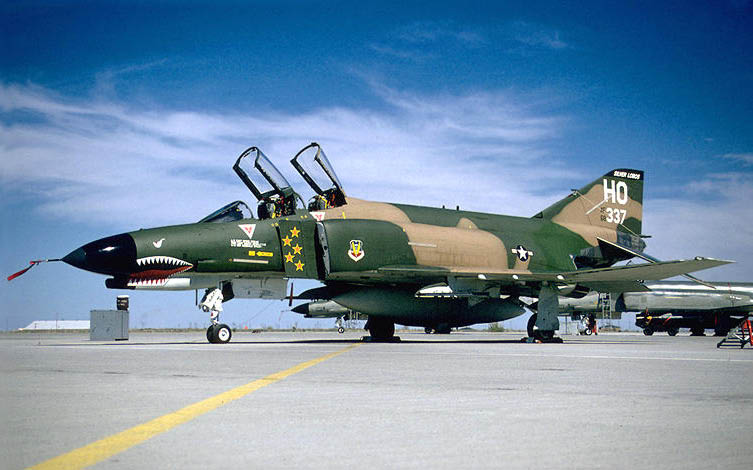
USAF 50th Anniversary Flight
Excerpts from an article appearing in Warbirds Magazine, 14 August 1997
It was a big week for the United States Air Force as they kicked off their 50th Anniversary year with the major air show called the Golden Air Tattoo at Nellis AFB, NV. It was also a big week for Brigadier General Steve Ritchie. General Ritchie was the only pilot ace that the Air Force had during the Vietnam conflict. He was the only American pilot to score five MiG-21 victories—a record he set while flying 800 combat hours in the F-4 Phantom II. Nineteen ninety-seven marked the 25th anniversary of his final MiG victory.
History was made at Nellis when Steve Ritchie returned to fly an F-4 Phantom for the crowds gathered there. The F-4E he flew, and the spare on static display, were both painted in jungle camouflage and both carried his name and five stars on the left side of the aircraft.

That this event could have happened at all is a tribute to the man, Steve Ritchie, the Air Force that supported him throughout his career, and a most resilient aircraft.
The F-4, designed by the McDonnell Aircraft Company, was the yardstick by which all other fighter aircraft were measured in the 1960s and ‘70s. First flown by the Navy, and later adopted by the Marines and the Air Force, the F-4 began service in 1959. The Phantom was the only fighter that was used by all three branches of the military. The last Squadron remaining was the 20th Fighter Squadron at Holloman AFB, NM. Holloman is where the Air Force fulfilled a contract to train pilots for the German Air Force. The Phantom was in the Air Force inventory for 34 years—longer than any other tactical fighter.
The vision to bring the Vietnam War ace and the Phantom together again belonged to then-Chief of Staff of the Air Force, General Ron Fogelman. General Fogelman. a historian, realized that there was a unique opportunity for Steve Ritchie to fly the Phantom. Brigadier General Ritchie was still flying a T-38 to various air shows in conjunction with his job as a recruiter. Could he requalify in the F-4? The aircraft were available at Holloman AFB, and Lockheed Martin offered to sponsor the dream by covering the cost of repainting two aircraft in the Vietnam “lizard” green paint scheme.
Steve Ritchie could hardly believe that this “dream,” for it had by this time become his dream too, might come to fruition. He arrived at Holloman AFB for four weeks of training which began in the classroom, progressed to the simulator, and went on to the flight training program which had been designed for him. It wasn’t a cake walk, and Steve suddenly realized how this now highly visible project and the confidence placed in him might backfire if he couldn’t requalify in the Phantom.
That thought had never occurred to him before he began flying the F-4 simulator. As Steve said: “They didn’t even have simulators for the F-4 when I learned to fly the plane. The simulator is lots harder to fly than the Phantom. Everyone kept saying that it was just like riding a bicycle, but that wasn’t the case. I wasn’t used to, and didn’t like, getting grade sheets that indicated my flying skills needed work.”
The instructors at the 20th Fighter Squadron were told to hold nothing back; Steve Ritchie would be safe and in control, or he wouldn’t fly. The stresses and demands of flying a high performance fighter are many. The pilot needs to be physically “fit,” coordinated, quick-thinking and cool headed. Could one retrain for something so demanding as operating a fighter in his mid-fifties? The pressure of doing well in what was becoming a highly visible endeavor must have been quite something, and Steve admits that it was a struggle at first.
“Comfort, while flying the aircraft, didn’t arrive until the sixth flight,” said Steve. “That was a long time to wonder if I had overextended myself.”
Steve Ritchie has nothing but praise for the 20th Fighter Squadron at Holloman. “They worked this project into their busy schedule, professionally and graciously. They are a good example of the teamwork that it takes to succeed.” The benefits of teamwork is a recurring theme in the message General Ritchie brings to hundreds of audiences every year.
“No one ever does anything alone. I didn’t down those MiGs without the support of hundreds of others doing their jobs day in and day out in a most professional manner. The victory be-longs to all of us. It takes teamwork and dedication to achieve success.”
Succeed Steve Ritchie did, because the hard work of all concerned paid off. At the end of the four weeks of training. General Ritchie took off from Holloman AFB heading for Las Vegas and the USAF’s 50th Anniversary; he was an F-4 pilot again. He and the F-4 Phantom are kindred spirits—still going.
And what will be his next challenge? A firm line of determination moves across his face like cloud shadows crossing a meadow. “The next project on my agenda is saving the Phantom.” Steve Ritchie is hoping that when the public sees these pristine F-4 Phantoms, they will become part of his team and make an effort to save these two from ever being used for a drone program. After all, it’s history in the making and in the saving for those with vision and determination.
[ My History ] [ Home ] [ Table Of Contents ]